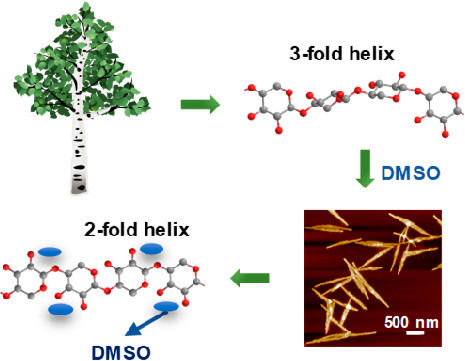Résumé:
« A new type of polysaccharide (hemicellulose) nanocrystal, bearing the shape of an anisotropic nanoflake, emerged from a dimethyl sulfoxide (DMSO) dispersion of wood-based xylan through heat-induced crystallization. The dimensions of these xylan nanocrystals were controlled by the crystallization conditions. Sharp signals in solid-state NMR indicated a well-ordered crystal structure. The unit cell is constituted of two asymmetric xylose residues, and DMSO molecules resided in a host–guest type of arrangement with more than one local environment. This corroborates with the identical 1H NMR relaxation time between DMSO and xylan, indicative of intimate mixing of the two at the tens of nanometer length scale. X-ray and electron diffraction indicated a 2-fold helical helix along the chain in a monoclinic unit cell with an antiparallel arrangement, with chains placed on the 2-fold helix axes: at the corner and at the center. The 2-fold helical structure is unique for xylan for which only a 3-fold helical form has been reported. The DMSO molecules participated in the crystallization, and they were shown to be vital in stabilizing the crystalline structure. The manipulation of temperature, concentration, and incubation time of the xylan/DMSO dispersion provided pathways for the crystallization to form size-adjustable nanocrystals. As 20–30% of biomass consists of hemicelluloses, this work will serve as a starting point to understand the controlled assembly of hemicelluloses to discover their full application potential. »
L’article est disponible ici.



